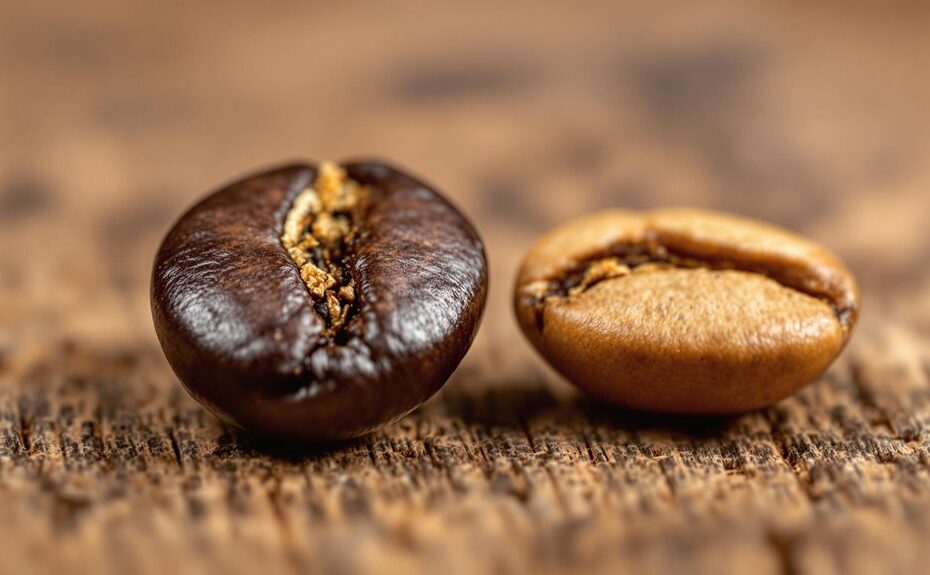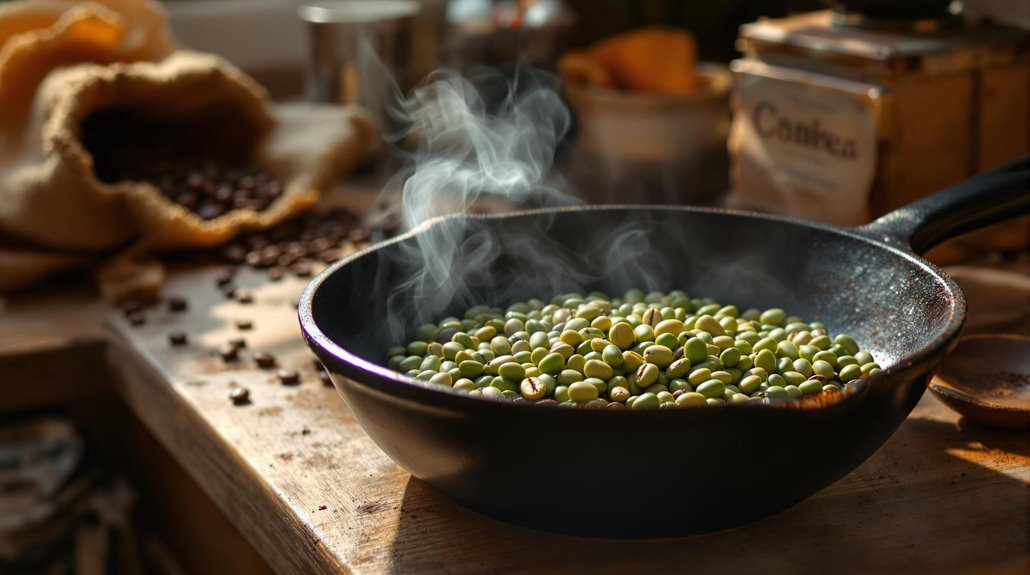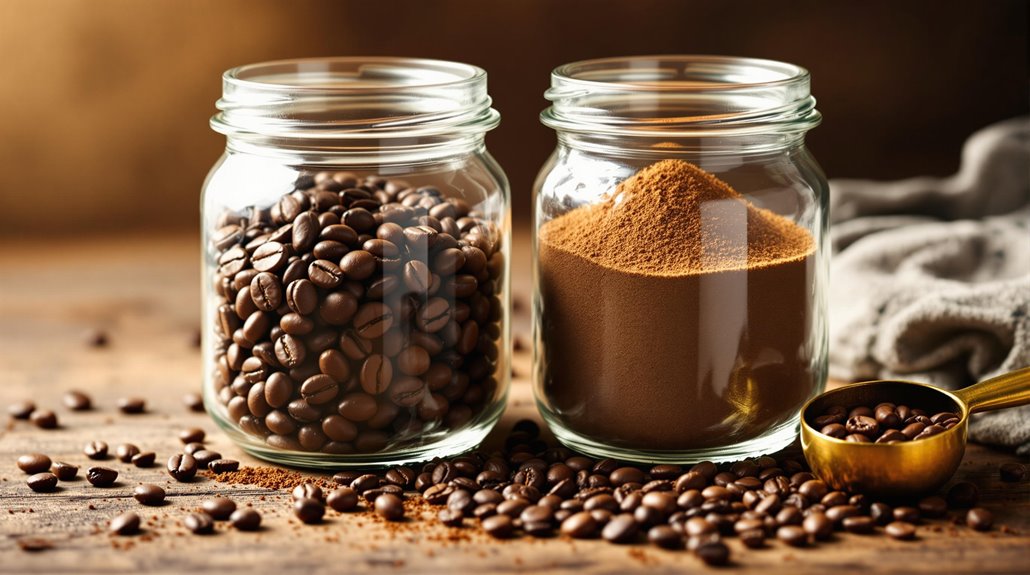







You might think all coffee beans taste the same, but the roast level changes everything. Light roast beans are roasted at lower temperatures, preserving their natural acidity and bright, fruity flavors, while dark roast beans undergo higher heat, developing bold, smoky notes and a caramelized richness. The caffeine content and bean density also shift with the roast, but which one packs more punch? And how does the roast level influence the brewing method you choose? The differences go deeper than just flavor—so, which roast truly suits your palate? The answer might surprise you.
Key Takeaways
- Light roast coffee is roasted at 356°F–401°F, preserving acidity, origin-specific flavors, and higher caffeine per bean.
- Dark roast coffee is roasted at 464°F–482°F, creating bold, smoky flavors with reduced acidity and slightly less caffeine per bean.
- Light roast beans are denser and heavier, while dark roast beans are lighter, less dense, and often oily.
- Light roast highlights bright, fruity, and floral notes, while dark roast emphasizes caramelized, chocolaty, and smoky flavors.
- Light roast is best brewed with pour-over or drip methods, while dark roast excels in espresso or French press brewing.
Roasting Process and Temperature Differences
How does the roasting process transform coffee beans into light or dark roasts? The key lies in temperature and timing. For a light roast, you'll roast beans at lower temperatures, typically between 356°F and 401°F, for about 9-11 minutes. The process stops just before or at the first crack, a popping sound signaling the beans' initial expansion. This preserves the beans' natural acidity, moisture, and origin-specific flavors, resulting in a denser, lighter-colored bean.
Dark roast, on the other hand, requires higher temperatures, ranging from 464°F to 482°F, and extends the roasting process to 12-13 minutes. Here, you'll continue roasting past the first crack and often through the second crack, a more intense snapping sound. This prolonged exposure reduces moisture, making the beans less dense and giving them a shiny, oily surface. The higher temperature and extended roasting time develop bold, smoky, and caramelized flavors, overshadowing the beans' original characteristics. Whether you're aiming for a light or dark roast, mastering the balance of temperature and timing is essential to achieving the desired roast profile.
Flavor Profiles of Light and Dark Roasts
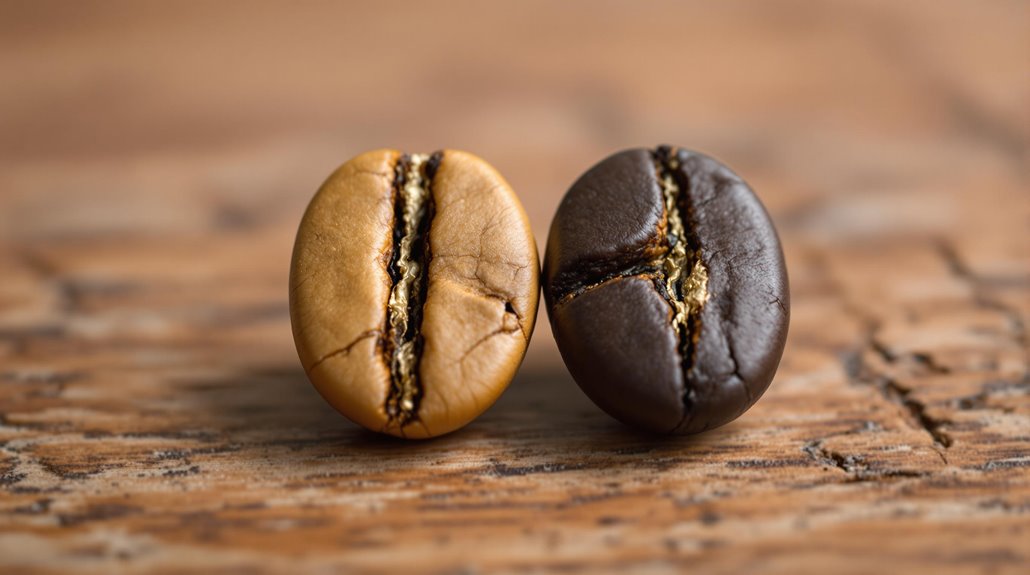
The flavor profiles of light and dark roast coffee beans are shaped by the roasting process, creating distinct sensory experiences. Light roast coffee, roasted at 356°F–401°F, retains higher acidity and origin flavors, offering bright, fruity, and floral notes. The shorter roasting time preserves the bean's natural characteristics, resulting in a vibrant and complex taste. You'll notice a pronounced acidity that highlights the bean's terroir, making light roasts ideal for those who appreciate nuanced, origin-specific flavors.
In contrast, dark roast coffee, roasted at 464°F–482°F, develops bold, smoky, and caramelized flavors. The prolonged roasting reduces acidity and creates a full body with a smoother, richer profile. Oils emerge on the bean's surface, enhancing the flavor and aroma with a robust, intense character. Dark roasts emphasize the roasting process over origin flavors, delivering a consistent, bold experience. If you prefer a coffee with a full body and deep, smoky undertones, dark roast is your go-to. Both roast levels offer unique flavor profiles, allowing you to choose based on your preference for brightness and complexity or richness and intensity.
Caffeine Content in Light Vs Dark Roasts

Ever wondered how caffeine content varies between light and dark roast coffee beans? Light roast beans retain slightly more caffeine per bean due to their shorter roasting time, which preserves higher caffeine levels. In contrast, dark roast beans lose some caffeine during prolonged roasting, resulting in lower caffeine content per bean. However, light roast beans are denser, meaning you'll need more beans to brew a cup, which can offset the caffeine difference when measured by volume. Dark roast beans expand during roasting, reducing their density and caffeine concentration per serving. When brewed, the caffeine difference between light and dark roasts is minimal. Light roast's higher caffeine per bean is balanced by its density, while dark roast's lower caffeine per bean is compensated by its lighter weight. Ultimately, the caffeine levels in your brewed coffee depend on how you measure the beans—by weight or volume. So, whether you prefer the bright acidity of a light roast or the bold richness of a dark roast, the caffeine content in your cup will be more similar than you might expect.
Bean Density and Moisture Retention
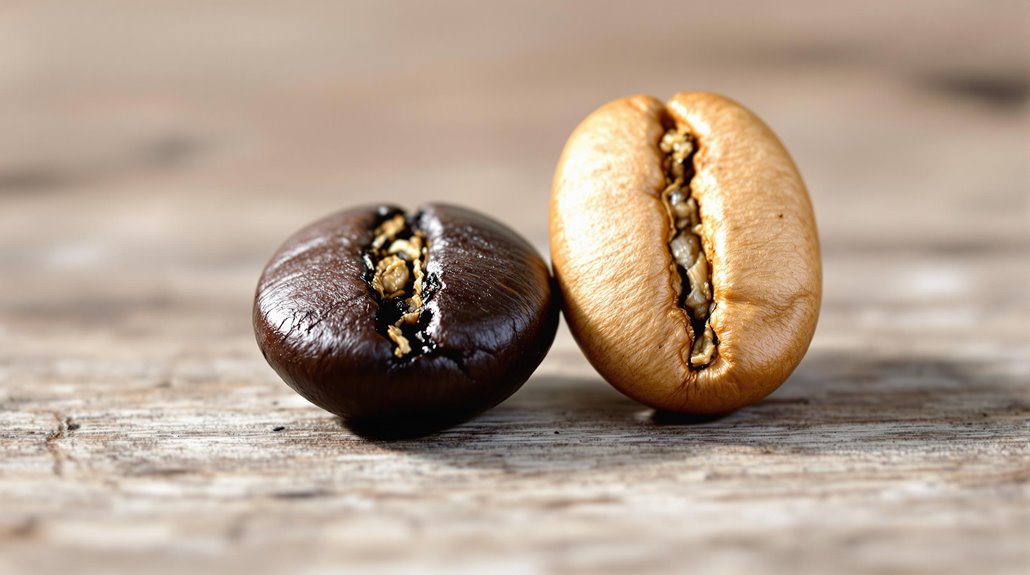
Light roast beans retain more moisture, making them denser and preserving their original acidity and nuanced flavors. Dark roast beans lose moisture during extended roasting, reducing their density and creating a lighter, more porous structure that enhances bold, smoky notes. The density difference also affects caffeine concentration, with light roasts packing slightly more per bean due to less expansion.
Moisture Content Differences
When roasting coffee beans, moisture content plays a critical role in determining both density and flavor. Light roast coffee retains a higher moisture content because it's roasted for a shorter time at lower temperatures. This results in denser coffee beans that are heavier and more compact. In contrast, dark roast coffee loses more moisture during the extended roasting process, making the beans less dense and lighter. The higher moisture content in light roast beans contributes to their brighter, more acidic flavor profile, as the organic acids and sugars remain largely intact. On the other hand, dark roast beans' reduced moisture content leads to a smoother, less acidic taste, as the prolonged heat breaks down these compounds. Understanding these moisture content differences is essential for achieving the desired flavor and texture in your brew. Light roast beans' denser nature means you'll need more beans by volume to match the weight of dark roast beans, which are less dense due to their reduced moisture. This distinction directly impacts your brewing measurements and the final cup's characteristics.
Density Impact on Flavor
Diving into the relationship between bean density and flavor, you'll find that moisture retention plays a pivotal role in shaping the taste of your coffee. Light roast beans retain more moisture, making them denser and preserving a complex flavor profile. This higher density allows more origin-specific characteristics to shine, as the beans retain their natural sugars, acids, and aromatic compounds. You'll notice brighter, fruitier, or floral notes in light roast coffee, reflecting the bean's origin and terroir.
In contrast, dark roast beans lose moisture during prolonged roasting, reducing their density. This creates a bolder, smokier flavor profile, as the extended heat breaks down the bean's structure and caramelizes its sugars. The lower density also leads to a fuller body and oilier surface, emphasizing roasted flavors over origin-specific nuances. While light roast highlights the bean's inherent qualities, dark roast shifts focus to the roasting process itself.
Bean density also impacts brewing. Light roast beans, being denser, require precise grind sizes to extract their nuanced flavors effectively. Dark roast beans, with their lower density, are more forgiving but deliver a heavier, more robust cup. Understanding density helps you tailor your brewing method to maximize flavor.
Roasting Effects on Density
Exploring the roasting process reveals how heat transforms coffee beans, directly influencing their density and moisture retention. When roasting coffee beans, light roasted beans retain more moisture, making them denser and heavier compared to dark roasted beans. This higher density in light roasts results from shorter exposure to heat, preserving their structural integrity and moisture content. In contrast, dark roasted beans undergo extended roasting, causing them to lose more moisture and expand, which reduces their density and makes them lighter. The density difference between light and dark roasts also impacts caffeine content; light roast beans contain slightly more caffeine per scoop due to their compact structure. Additionally, the higher density of light roast beans makes them more resistant to breaking during grinding, while dark roast beans, being less dense, are more fragile. Understanding these roasting effects on density helps you appreciate how light and dark roasts differ not just in flavor but also in their physical properties, influencing everything from brewing to caffeine extraction.
Brewing Methods for Each Roast Type
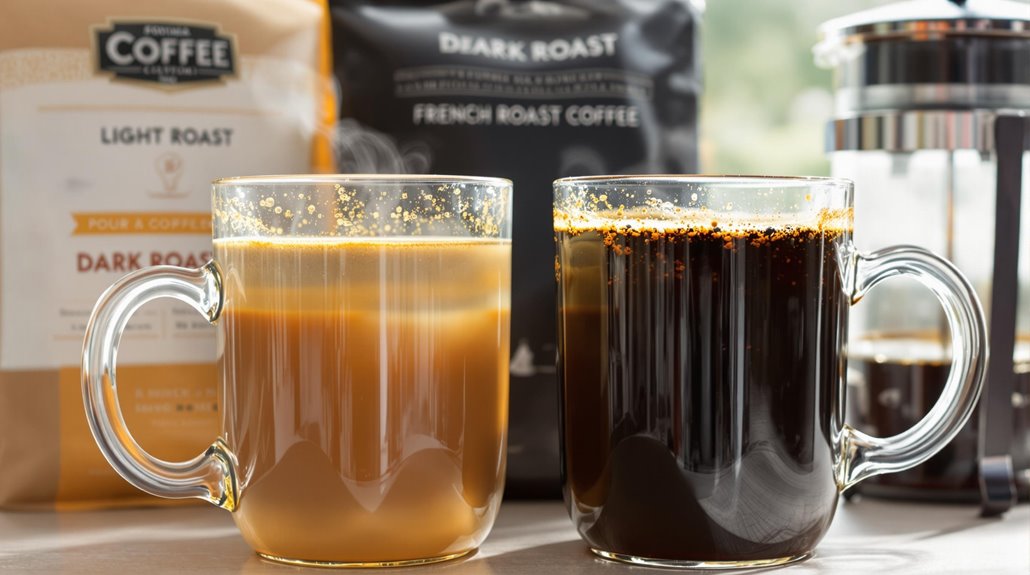
Light roast coffee beans often shine brightest when brewed using methods like pour-over or drip coffee, as these techniques accentuate their bright acidity, floral notes, and delicate complexity. For light roast coffee, you'll want to maintain a precise water temperature between 195°F and 205°F to preserve its nuanced flavors. Single-origin light roasts are particularly well-suited to pour-over brewing, as this method highlights their unique origin characteristics, such as fruity or floral undertones. Avoid over-extraction, which can mask the subtlety of light roast coffee.
Dark roast coffee, on the other hand, thrives in brewing methods like espresso or French press, which complement its bold, smoky, and robust profile. The French press's immersion brewing style enhances the dark roast's full-bodied texture, while espresso extraction intensifies its rich, caramelized flavors. Dark roast coffee can handle higher brewing temperatures, making it versatile for methods like Moka pot or cold brew. Its adaptability also makes it a popular choice for espresso-based drinks, where its deep flavors balance well with milk or syrups. Choose your brewing method based on the roast type to reveal the best flavor potential.
Bitterness and Sweetness in Coffee Roasts
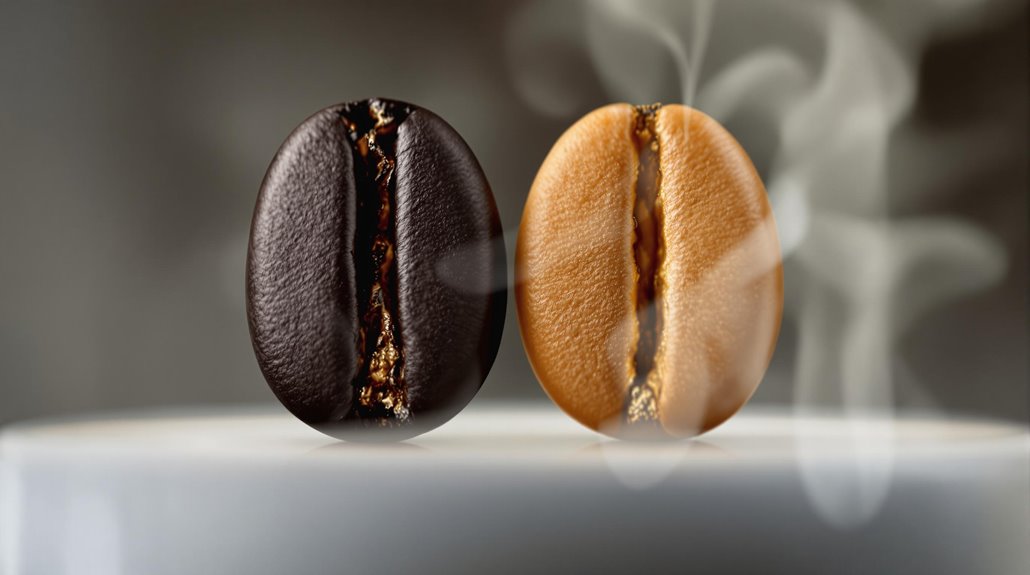
You'll notice that acidity levels in light roasts can heighten perceived bitterness, but they're often balanced by the bean's inherent sweetness and vibrant fruity notes. In dark roasts, extended roast times break down chlorogenic acid, increasing bitterness, while sugar caramelization during the Maillard reaction introduces a deeper, caramel-like sweetness. The interplay between roast time and cooling rates ultimately shapes the balance of bitterness and sweetness in your cup.
Acidity Levels Impact Bitterness
Understanding the relationship between acidity levels and bitterness in coffee roasts reveals how roasting impacts flavor. In light roast coffee, higher acidity levels, driven by organic acids like citric and malic acid, can create a bright, tangy profile that some perceive as bitterness. This is because the roasting process preserves chlorogenic acid, a compound that contributes to both acidity and a sharp, astringent taste. However, in dark roast coffee, prolonged roasting breaks down chlorogenic acid, reducing overall acidity and shifting the flavor profile. As chlorogenic acid degrades, it forms quinic acid, which introduces a different, often harsher bitterness compared to light roasts. The roasting process also develops other flavor compounds through caramelization and Maillard reactions, which can add depth but also contribute to a smoky or burnt bitterness. While light roast's natural sweetness may be masked by its acidity, dark roast's bitterness stems more from the roasting process itself. By understanding how acidity and roasting influence bitterness, you can better appreciate the distinct characteristics of each roast.
Sugar Caramelization Affects Sweetness
Sugar caramelization plays a key role in shaping the sweetness and bitterness of coffee roasts, with light and dark roasts showcasing distinct outcomes. In light roast coffee, sugar caramelization occurs at lower temperatures (356°F–401°F), enhancing the bean's natural sweetness while preserving more chlorogenic acid. This results in a brighter, sweeter flavor profile with subtle fruity or floral notes. The Maillard reaction, which begins at these temperatures, contributes to the development of simpler, sweeter compounds without overwhelming the inherent sweetness of the bean.
In contrast, dark roast coffee undergoes prolonged roasting at higher temperatures (464°F–482°F), causing sugars to caramelize further and eventually degrade. This process reduces the bean's natural sweetness and increases bitterness, as the Maillard reaction progresses into more complex, smoky, and roasted flavors. The breakdown of sugars and chlorogenic acid in dark roast leads to a bolder, more bitter cup, masking the original sweetness. While dark roast offers depth and richness, it sacrifices the delicate sweetness that light roast preserves. Understanding sugar caramelization helps you appreciate how temperature and roast level influence the balance of sweetness and bitterness in your coffee.
Roast Time Determines Flavor Balance
How does roast time shape the balance between bitterness and sweetness in your coffee? Roast time directly influences the flavor profile by controlling how much acidity, sweetness, and bitterness develop. In a light roast, beans are roasted for a shorter duration, typically reaching internal temperatures of 356°F–401°F. This preserves natural sugars and organic acids, resulting in a brighter, sweeter cup with pronounced acidity. The Maillard reaction, which begins early in roasting, enhances these flavors without pushing the beans into bitter territory.
In contrast, dark roast coffee undergoes extended roast time, reaching temperatures of 464°F–482°F. The longer exposure breaks down more sugars, intensifying bitterness while reducing sweetness. Caramelization dominates, creating bold, smoky, and sometimes charred notes. The acidity diminishes as the roast progresses, leaving a heavier, more robust flavor.
Your choice between light and dark roast hinges on whether you prefer a vibrant, sweet, and acidic brew or a deep, bitter, and full-bodied cup. Roasting transforms the bean's chemistry, and understanding roast time helps you craft the perfect balance of bitterness and sweetness to suit your palate.
Popular Light and Dark Roast Varieties

Exploring the world of coffee, you'll find that light and dark roast varieties each bring distinct flavor profiles shaped by their roasting processes. Light roast coffees like Ethiopia Yirgacheffe highlight floral and citrus notes, while Colombia Huila offers bright acidity with fruity undertones. These beans retain more of their origin characteristics due to shorter roasting times, making them ideal for those who appreciate nuanced, vibrant flavors. On the other hand, popular dark roasts include French Roast, known for its bold, smoky intensity, and Sumatra Mandheling, which delivers an earthy, full-bodied experience. Italian Roast, another dark roast favorite, provides a rich, caramelized taste with a slight bitterness, often used for espresso. Espresso Roast, specifically designed for brewing methods requiring high pressure, offers a robust, chocolaty finish. Whether you prefer the bright, complex notes of light roasts or the deep, intense flavors of dark roasts, each variety reflects the artistry of roasting and the unique qualities of its origin. Your choice ultimately depends on the flavor experience you seek.
How Roast Level Affects Coffee Acidity
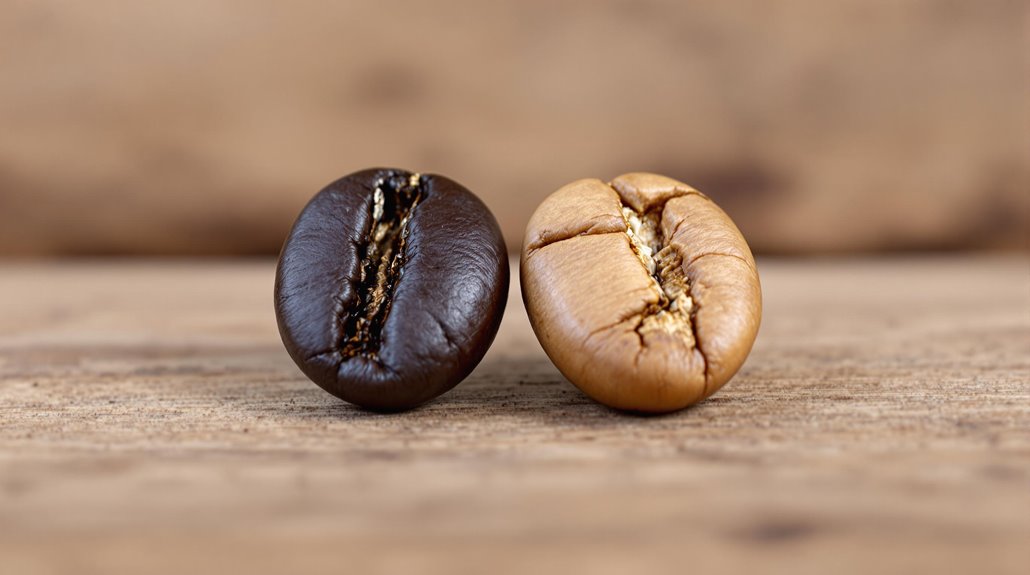
The roast level of coffee beans substantially influences their acidity, shaping the flavor profile you experience in your cup. Light roast coffee retains higher acidity levels, with a pH range of 4.5 to 5.0, due to shorter roasting times preserving organic acids like citric and malic acid. These acids contribute to the bright, tangy notes often described as "crisp" or "vibrant." Chlorogenic acid, a key component of coffee's acidity, remains abundant in light roast, enhancing its lively, complex flavor. In contrast, dark roast coffee has lower acidity, with a pH range of 5.5 to 6.0, as prolonged roasting breaks down organic acids, including chlorogenic acid, which decreases by up to 50%. This reduction results in a smoother, less tangy flavor, often perceived as "mellow" or "rounded." The extended roasting times also caramelize sugars, shifting the focus from acidity to bold, rich, and caramelized flavors. Understanding how roasting times impact acidity helps you appreciate the distinct characteristics of light roast and dark roast, each offering unique sensory experiences based on their pH and organic acid composition.
Choosing Between Light and Dark Roasts
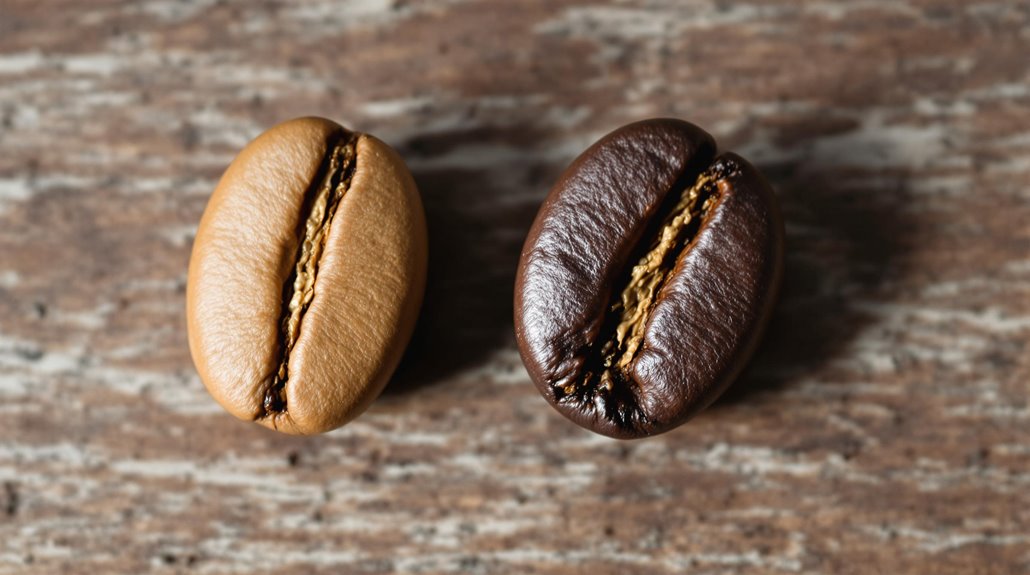
When deciding between light and dark roast coffee, it's essential to evaluate how roasting temperatures and times shape the flavor profile and brewing experience. Light roast coffee beans are roasted at 385°F to 410°F, preserving their bright, fruity, and floral flavors, along with higher acidity. These beans retain more moisture and density, making them ideal for pour-over or drip brewing methods that highlight their delicate, origin-specific characteristics. If you prefer a crisp, nuanced cup with slightly more caffeine per bean, light roast is your go-to.
Dark roast coffee beans, roasted above 430°F, develop bold, smoky, and chocolaty notes, with a less dense structure due to moisture loss. This roast level masks the bean's origin flavors, focusing instead on the caramelized, robust qualities. Dark roast excels in espresso or milk-based drinks, where its intense flavor cuts through. While it has marginally less caffeine per bean, the difference per cup is negligible. Choose dark roast if you crave a full-bodied, smoky experience. Your brewing method and flavor preferences will ultimately guide your decision between light and dark roast.
Disclosure: As an Amazon Associate, I earn from qualifying purchases.
